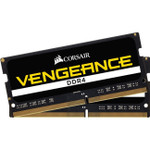High performance DDR4 SODIMM for Intel 6th generation Core platform systems
Corsair Vengeance Series DDR4 SODIMM memory modules are designed for high performance and reliability on 6th generation Intel Core systems, with ICs specially selected for performance potential. No configuration is required to take advantage of the higher speed - just plug it in and go.
Corsair Vengeance Series DDR4 SODIMM memory modules are designed for high performance and reliability on 6th generation Intel Core systems, with ICs specially selected for performance potential. No configuration is required to take advantage of the higher speed - just plug it in and go.
Designed for laptop and notebook PCs
Virtually all notebook and laptop PCs use SODIMM memory modules. Some systems use the DDR4 SODIMM standard, and some use the older DDR3 SODIMM standard. Not sure which type you need? We're here to help.
Automatic overclocking for automatic maximum performance
Most notebook and laptop PCs will automatically select the maximum reliable overclocking settings for the best possible performance and 100% stability. In most cases, no manual configuration is necessary. Upgrading to Vengeance Series DRAM is a great way to give your system an instant speed boost.
- Enables efficient and smooth execution of all your heavy-duty applications with maximum productivity
- Up to 2666 MHz speed with CL18 latency for smooth computer performance
- SoDIMM 32 GB of memory can produce approx. 10K MIPS and as a result, your system gets more room to run complex apps.
- DDR4-2666/PC4-21300 interface multiplexes 2-bit data from memory cell and I/O buses to minimize processor idle time and enhance your computer's performance
- 2 x 16GB modules for quick access and retrieval of data and information to ensure maximum usability
- 260-pin for enhanced, dependable system performance with maximum usability
- CL18 CAS latency for reliable, fast response and improved performance
- SoDIMM form factor with 260-pin and 32 GB memory size for enhanced performance and speed to allow maximum usability


































